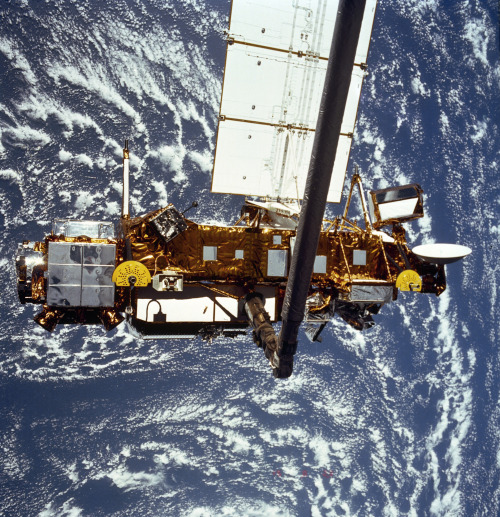
WASHINGTON (AP) _ It's as big as a bus and weighs 6 tons, but officials probably will never be able to pinpoint exactly where a massive NASA satellite plummeted to Earth.
NASA space junk scientists believe that all _ or nearly all _ of the parts of their 20-year-old dead satellite safely plunged into the Pacific Ocean, likely missing land. But if their estimates are off, by only five minutes or so, fiery pieces could have fallen on parts of northwestern North America.
No injuries or damage have been reported on land, which NASA officials said was a good indication the satellite went into the ocean.
That doesn't necessarily mean it all fell into the sea. Some debris could have fallen over areas such as Portland, Oregon; Seattle; Calgary, Alberta; and Saskatoon, Saskatchewan, said Jonathan McDowell of the Harvard-Smithsonian Center for Astrophysics.
``Pieces are falling off of this flaming fire ball, and some of it has enough momentum to go hundreds of miles,'' he said.
Speculation was rampant on sites such as Twitter. There were no credible reports of debris on the ground, said Nick Johnson, NASA's chief scientist for orbital debris. But if the satellite fell even five minutes later than estimated, some of it could have hit land, he said.
``We don't know where the re-entry point exactly was. We don't exactly know where the debris field is,'' Johnson said.
NASA's earlier calculations had predicted that the former climate research satellite would fall over a 500-mile (800-kilometer) swath and could include land. Officials said the 35-foot (11-meter) satellite fell sometime between 11:23 p.m. EDT Friday (0323 GMT Saturday) and 1:09 a.m. EDT (0509 GMT) Saturday.
Much of the speculation focused on unconfirmed reports and even video of debris from the Upper Atmosphere Research Satellite over Alberta, Canada.
NASA spokesman Steve Cole said that was possible because the last track for the satellite included Canada, starting north of Seattle and then in a large arc north then south. From there, the track continued through the Atlantic south toward Africa, but it was unlikely the satellite got that far if it started falling over the Pacific.
Some 26 pieces of the satellite representing 1,200 pounds (544 kilograms) of heavy metal had been expected to rain down somewhere. The biggest surviving chunk should be no more than 300 pounds (136 kilograms).
NASA urges anyone who thinks they've found satellite debris to call police. It's government property and illegal to keep it or try to sell it. The debris has no toxic contamination, but there could be sharp edges, NASA officials have said.
UARS is the biggest NASA spacecraft to crash back to Earth, uncontrolled, since the post-Apollo 75-ton Skylab space station and the more than 10-ton Pegasus 2 satellite, both in 1979.
Russia's 135-ton Mir space station slammed through the atmosphere in 2001, but it was a controlled dive into the Pacific.
Before UARS fell, no one had ever been hit by falling space junk and NASA expected that not to change.
NASA put the chances that somebody somewhere on Earth would get hurt at 1-in-3,200. But any one person's odds of being struck were estimated at 1-in-22 trillion, given there are 7 billion people on the planet.
The satellite ran out of fuel and died in 2005. UARS was built and launched before NASA and other nations started new programs that prevent this type of uncontrolled crashes of satellite.
<한글기사>
위성 잔해 加·태평양에 추락…피해보고 없어
(워싱턴 AFP=연합뉴스) 사용 연한이 다한 6t 무게의 관측 위성이 한국시각으로 24일 오후 12시23분~2시9분에 대기권에 진입, 추락한 것으로 파악됐다.
정확한 추락 지점은 확인되지 않고 있으나 대체로 태평양과 캐나다 쪽으로 떨어 졌을 것으로 추정된다.
미국 항공우주국(NASA)은 초고층대기관측위성(UARS)이 그리니치표준시(GMT)로 2 4일 오전 3시23분~5시9분에 지구상으로 떨어졌다고 밝혔다.
NASA는 반덴버그 공군기지 내 합동우주사령본부가 위성이 태평양 상공을 통해 대기권에 진입했다는 정보를 보내왔다면서 "위성은 동쪽 방향으로 캐나다와 아프리 카, 태평양과 대서양, 인도양 상공의 넓은 부분을 통과했다"고 설명했다.
NASA는 이 위성의 정확한 추락 지점이 확인되지 않았다면서도 "파편이 만약 육 지에 떨어졌다면(굳이 가정하자면) 캐나다가 가장 가능성이 큰 지역"이라는 글을 트 위터에 올렸다.
실제로 트위터에는 캐나다 캘거리 남쪽의 오코톡스 마을에 잔해가 떨어졌다는 트윗이 올라오고 있다.
앞서 NASA는 추락 중 타지 않고 대기권을 통과한 잔해의 양은 무게 1~158㎏ 범 위의 20개 정도로, 약 800㎞에 걸친 지역에 떨어질 것이라고 예상했었다.
아직까지 추락한 위성 파편에 의한 피해는 보고되지 않았다.
한편, NASA의 궤도 잔해 전문가인 마크 매트니는 "50년 이상 된 우주 연구 역사 에서 떨어지는 위성 잔해에 맞은 사람은 하나도 없다"면서 인명 피해 가능성을 일축 했다. (연합뉴스)


![[AtoZ into Korean mind] Humor in Korea: Navigating the line between what's funny and not](http://res.heraldm.com/phpwas/restmb_idxmake.php?idx=644&simg=/content/image/2024/04/22/20240422050642_0.jpg&u=)
![[Exclusive] Korean military set to ban iPhones over 'security' concerns](http://res.heraldm.com/phpwas/restmb_idxmake.php?idx=644&simg=/content/image/2024/04/23/20240423050599_0.jpg&u=20240423183955)



![[Graphic News] 77% of young Koreans still financially dependent](http://res.heraldm.com/phpwas/restmb_idxmake.php?idx=644&simg=/content/image/2024/04/22/20240422050762_0.gif&u=)
![[Herald Interview] Why Toss invited hackers to penetrate its system](http://res.heraldm.com/phpwas/restmb_idxmake.php?idx=644&simg=/content/image/2024/04/22/20240422050569_0.jpg&u=20240422150649)





![[Exclusive] Korean military to ban iPhones over security issues](http://res.heraldm.com/phpwas/restmb_idxmake.php?idx=652&simg=/content/image/2024/04/23/20240423050599_0.jpg&u=20240423183955)



![[Today’s K-pop] Ateez confirms US tour details](http://res.heraldm.com/phpwas/restmb_idxmake.php?idx=642&simg=/content/image/2024/04/23/20240423050700_0.jpg&u=)